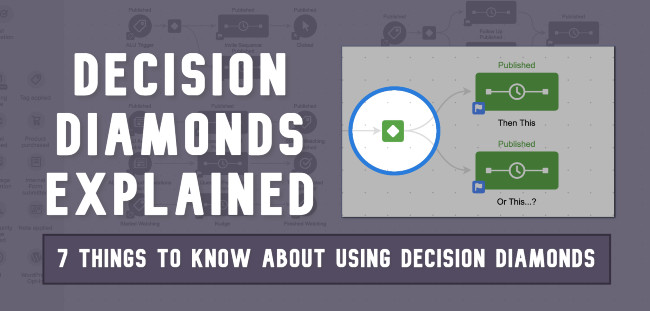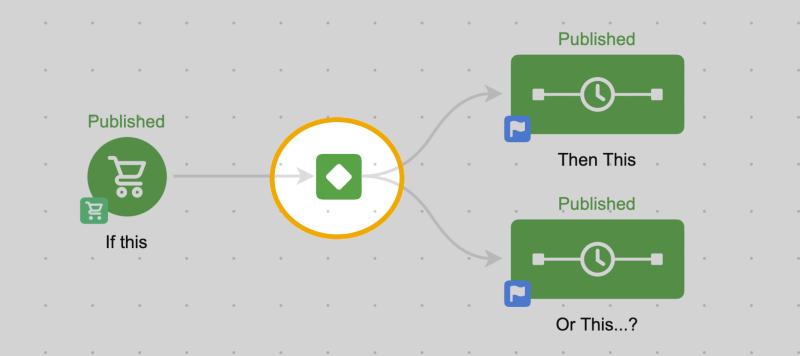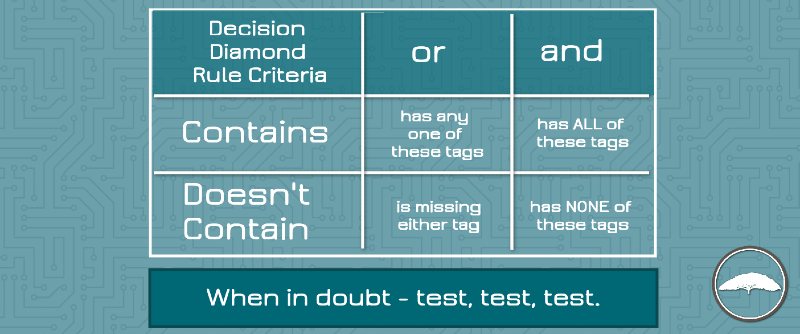The campaign builder is the most popular part of Keap – and decision diamonds are a critical piece of what makes it so powerful.
In this blog post I’m going to answer some of the most common questions Keap (formerly Infusionsoft) users have about using decision diamonds in their campaigns.
Click on the link to jump to one of the specific questions:
If reading feels like a whole thing and you prefer the video version of this conversation then click here to jump to the video summary.
And if you find yourself wanting more information on decision diamonds, or the campaign builder in general, I recommend checking out this Campaign Builder 101 post, or hopping on the free trial of my CB Trilogy course.
Okay then – first up, what are they?
What are decision diamonds?
Well, simply put – decision diamonds are a node in the campaign builder that route contacts in different parts of your campaign.
I think of it like the little ticket taker at one of those massive 24-theater Movie complexes. When a contact hits that point of the campaign, the decision diamond rips their ticket and points them in the right direction.
This brings us to the next question – why do they matter?
Why are decision diamonds valuable?
Decision diamonds are valuable for one simple reason – segmentation.
They allow us to treat different people differently, based on what we know about them.
This type of robust segmentation is really what helps Keap (formerly Infusionsoft) users create automation that doesn’t feel quite so….automated.
As you might know, the campaign builder works off of goals and sequences – which basically work out to “if this, then that” style logic.
If this goal is achieved, then add the contact to this sequence.
And you can totally build campaigns using this formula – goal, sequence, goal, sequence.
(In fact, that’s absolutely how I recommend most people start – keep it simple when you can.)
However, it’s only a matter of time until you run into a scenario where you want different things to happen after a goal is achieved – based on any number of factors, and this is where decision diamonds come in.
They allow us to create different outcomes for the same action – so, two people fill out the same web form, but receive different follow up.
There are any number of reasons you might want to have different outcomes after an action – like, different behavior for people based on whether they’re a repeat buyer, or a new buyer; or different automation based on where they live in the world, or some other detail about themselves.
Which brings us to the next question – what information can I use?
What criteria is available for decision diamonds?
In general, decision diamonds can access contact information – which means field data, and tags.
This might sound basic, but it opens up a lot of possibilities for us – because it means we can not only access their general contact details, like their city or state, or whether or not they have a phone number on file, but it also means we can check the value of any of the custom fields we’ve created.
A simple use case would be if you ask a question on the opt-in, you can then tailor the automated response that is sent to match the answer that contact gave you as they were signing up.
This could mean using examples you know are relevant for that person – or even changing what product or service you recommend for them.
It’s worth pointing out that the options for building your rules change based on the type of field you’re using – so, if its a whole number field you can do greater than and less than, whereas if it’s a text field you’d do things like contains, or doesn’t contain.
In addition to the contact fields you can also use tags to create rules.
This makes decision diamond criteria infinitely more flexible, because tags can be applied automatically anytime someone takes an action. So, if you’re using the presence of tags to track behaviors – like, filling out a web form, clicking a link, or buying a product, then now you can use the contacts behavior (represented by tags) to route the contact into different sequences based on what they have or haven’t done.
And finally, decision diamonds can also access the data collected in a web form- meaning the selections a contact makes in radio options and checkboxes on Infusionsoft web forms and legacy landing pages.
This one is lesser known because this option really only shows up when a decision diamond is used immediately following the web form (or legacy landing page).
You might be thinking “man, these things are powerful – do they have any drawbacks?”
What limitations do decision diamonds have?
Decision diamonds have a few limitations – first, and most notably, at this point the rules you build are really only able to use information from the contact record itself.
That means you can’t use order details, opportunity details, or design rules using logic based off of the time of day, or the date.
My hope is that they’ll expand that over time (or soon would work too), and introduce some new flexibility that lets us segment contacts based on whether they used a promo code in their order, or if they’ve spent over $X with us over their lifetime, etc; but in the meantime we can create workarounds for most those scenarios using tools like Zapier, FixYourFunnel Bots, or PlusThis to copy information into custom fields, or to tags.
Another limitation for decision diamonds is that they can only use the information available at the time the contact hits that point in the campaign.
This isn’t so much a drawback as it is just something to be aware of – the decision diamond is a filter that assesses the contact using the rules you’ve created and then sorts it into one of the sequences options you’ve designed.
Like the Hogwarts Sorting Hat (I’m a ravenclaw, btw).
But if the contact’s information changes after they’ve been sorted, it doesn’t re-evaluate using the new info because the contact has now passed that point in the campaign.
Like I said – this isn’t necessarily a drawback – it’s just important to understand so you can build your campaigns to accommodate for that.
Alright – so you know the pros and cons, let’s talk about how to actually use it.
How do I add a decision diamond?
Decision diamonds are maybe the only element in Keap’s campaign builder that aren’t actually added by the user.
They don’t live on any of the menus – which can definitely be confusing at first, because it leaves users wondering “how do I add it…”
The answer is generally one of those facepalm moments: They show up when they’re needed.
(Kinda like the Room of Requirement, just to keep the Harry Potter references rolling.)
Decision diamonds appear when the campaign builder notices there are more than one possible outcome for an action, and it wants us (the user) to help it decide when to send people where.
So if you have one goal leading to one sequence – no decision diamond needed.
It knows exactly what to do when that goal is achieved.
But if you have one goal leading to two (or more) sequences, then poof – the decision diamond pops in asking us to set up the rules that determine when they go where.
How do I configure the decision diamond rules?
Like any element in the Keap campaign builder, you’ll double click on the decision diamond when you want to configure it.
This takes you into the interface where you can design the rules for each sequence.
If you don’t design rules the default is that the contact will go into each of the available sequences – sometimes that’s okay, but normally you’ll want to set up rules so that they only go into the sequences that make the most sense for them.
Building the rules is kinda like creating a mad libs sentence – just follow the prompts.
It uses boolean logic, which can get a little complex – so my advice is to try and keep your rules simple, and always always test your logic.
Here’s the cheat sheet I refer back to when in doubt.
Two things to look out for here:
- You can copy rules from one sequence to another, which can reduce the opportunity for human error when you’re creating multiple similar rules.
- You can also define a default outcome for people who don’t meet the criteria for any of your rules – choosing to let them drop out of the campaign, or, placing them in one of the sequences anyway.
Once you’ve set up your rules (and run a few tests), just go back to the campaign level. If the goal and sequences on either side of the diamond are set as ready then the diamond should be ready to publish too.
Here’s a little more documentation from the Keap help center.
And here’s a video from Box Out Marketing’s 12 Hacks of Christmas series where Tyler talks about testing decision diamonds.
The final question I’ll tackle in this post is one I’ve been hearing more and more lately.
Does Dynamic Content replace the need for decision diamonds?
Short answer: No.
Longer answer: Sometimes.
Dynamic Content, also known as Liquid Content, is a feature Keap quietly released at the start of 2020 – and it’s terrific.
You can read more about it here if you’d like, but basically it allows you to hide or show different parts of an email based on what you know about the recipient.
This type of advanced personalization is huge – and it absolutely reduces the need for decision diamonds (because we can do things like hide the CTA for someone who has already purchased).
But even with as flexible as dynamic content can be, it only changes the email content – not the overall experience.
So, decision diamonds are still the best bet for when you want to create two totally different sets of automation – like, sending a single email to some people and an entire email series to others.
Video Version
If you’re the type of person who likes your answers read to you aloud, then here’s a summary video answering all seven questions. Enjoy
Conclusion
Alright party people – I hope this has been useful and given you some more confidence for using decision diamonds throughout your Keap campaigns.
If you are interested in learning more about the campaign builder check out this Campaign Builder 101 blog post or this Campaign Builder Finishing School video series.
If you have any feedback, or specific questions about decision diamonds, drop a comment below. Thanks for reading.
Bonus Use Case
I believe that pretty much every campaign ever built could be improved through the use of a decision diamond – simply because adding segmentation means you’re able to personalize the experience you’re creating for people. Which is always a good thing.
Here’s a simple (and common) use case for how a decision diamond might fit:











